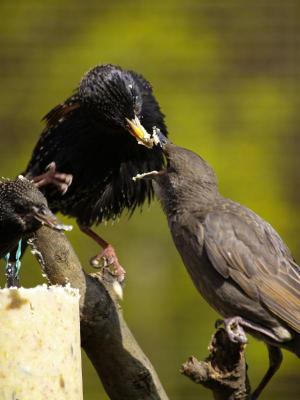Considerable attention has been paid to the effects of endocrine disrupting chemicals in aquatic environments, but rather less attention has been given to routes of contamination on land. A new study by researchers at Cardiff University, reveals that wild birds foraging on invertebrates contaminated with environmental pollutants, show marked changes in both brain and behaviour: male birds exposed to this pollution develop more complex songs, which are actually preferred by the females, even though these same males usually show reduced immune function compared to controls.

|
| ©iStockphoto/Andrew Howe
|
| European starling feeding a fledgling. Researchers found that those birds exposed to environmentally-relevant levels of synthetic and natural estrogen mimics developed longer and more complex songs compared to males in a control group.
|
Katherine Buchanan and her colleagues studied male European starlings (Sturnus vulgaris) foraging at a sewage treatment works in the south-west UK and analysed the earthworms that constitute their prey. The researchers found that those birds exposed to environmentally-relevant levels of synthetic and natural estrogen mimics developed longer and more complex songs compared to males in a control group.
Specifically, birds dosed with the complete spectrum of endocrine disrupting chemicals found in the invertebrates spent longer singing, sang more often and produced more complex songs, a sexually selected trait important in attracting females for reproduction even though birds dosed at these ecologically relevant levels also showed reduced immune function.
The study also addresses the mechanism for this effect, as the researchers found that the high vocal centre (HVC), the area of the brain that controls male song complexity, is significantly enlarged in the contaminated birds. Estrogen causes masculinisation of the songbird brain and the HVC is enriched with estrogen receptors. Neural development is thus susceptible to exposure to chemicals which mimic estrogen, or to enhanced estrogen levels. The results also confirm the plasticity of the adult songbird brain.
Finally, the scientists found that female starlings prefer the song of males exposed to the mixture of endocrine disrupting chemicals, suggesting the potential for population level effects on reproductive success.
"This is the first evidence that environmental pollutants not only affect, but paradoxically enhance a signal of male quality such as song," said Katherine Buchanan, the corresponding author of the paper. "These results may have consequences of population dynamics of an already declining species."
Citation: Markman S, Leitner S, Catchpole C, Barnsley S, Müller CT, et al (2008) Pollutants Increase Song Complexity and the Volume of the Brain Area HVC in a Songbird. PLoS One 3(2): e1674. doi:10.1371/journal.pone.0001674http://www.plosone.org/doi/pone.0001674
Adapted from materials provided by Public Library of Science.

Reader Comments
to our Newsletter